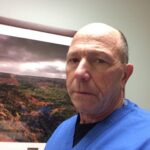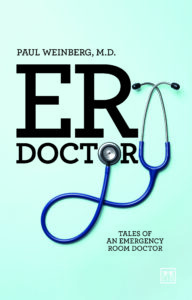|
While You Are Sleeping: What’s Happening in the ER between 2:30 and 5:30 am by Paul Weinberg
By Guest Contributor Paul Weinberg, Author of ER Doctor
As an EM physician, almost half the work takes place during the darkest hours. ERs do not close, and, in my busy urban practice, there was little time to sleep during night shifts.
Big-time motor vehicle accidents, and I mean big wrecks, arrive in the early morning after the bars and after-hours places close. As the darkness goes, there is often an extremely intoxicated driver involved in a crash. The blood alcohol levels in these cases are easily four to five times the legal limit of intoxication. The “victims” are hardly aware of what’s going on and they don’t smell great, either.
There is nothing like the night shift to reveal the unknown side of life.
For most people, the hours of late darkness – from 11:00 p.m. to 5:00 or 6:00 a.m. – are not well known, only explored on New Year’s Eve, on a long airplane flight or in the face of an emergency. The darkness of the night shift brings with it the domestic violence, drug overdoses, suicide attempts, severe alcoholic intoxication, shootings, stabbings, assaults of all types and sudden eye pains (the dilating pupil contributes to increased pressure within the eye).
Delay, neglect and decay are also the hallmarks of the night shift. The lacerations are longer, the wounds more delayed in presentation, and the patients crankier, less sanitary, articulate and educated.
The first battle for the night begins with the fatigue and bodily disruption of a disturbed circadian rhythm. This rhythm controls aspects of many cellular functions and as the cells go, the body goes too. Memory becomes impaired, the body feels tired, beat-up and cold.
The vast majority of people are obligate day-timers awakened by daylight and asleep after it gets dark. On camping trips or during extended times without electricity, I have gone to sleep about 45 minutes after dark and then awakened at dawn. This has always felt good to me.
A visit to the waiting room of a busy ER during the early morning hours provides a glimpse into the surrounding community in a whole new light. The variety and range of the people waiting will open the mind and eyes to the more hidden lives of the locals.
I used to ask people, “Why did you come to the ER now?” during the early morning hours between 2:00 and 5:00 a.m. From a medical standpoint, these people were stable and had no urgent need to be seen.
I finally stopped asking.
There was always some reason that finally revolved around fear – the hours of darkness, isolation and loneliness – the kind of things that could have been eased with a shot of whiskey, petting a dog, snuggling a warm body, chocolate or even a readjustment of the circadian rhythm through light therapy.
The reason I stopped asking was because I knew their pain and emptiness from the many times I, too, had stayed up into the wee hours learning the practice of medicine.
However, in urban areas, there is so much nightlife that there are an equal number of people awake during the day and night. Ask any cop or ER worker, the night-crawlers are a different bunch. In general, they are not as civilized as the day-timers. They have a different rhythm and sense of ethics.
Most of the time, night shift patients could be described as somewhat off. Many of my night shift patients would make folks glad to have doors with locks and police around. Of course, they are interesting – interesting to assess, understand and observe their situations – but only for the length of a visit.
The memories of my feelings during the hours of 2:30 to 5:30 a.m. are not comforting or pleasant. The necessity to work those hours began to wear me down over time. The intensity of the unpleasant feelings increased over the years until it was almost intolerable.
I began each night shift filled with dread, dread over my own anticipation of what would occur in the unpleasantness of the early morning hours. Some nights, it felt as though daylight would never return. Over time I was able to monitor my feelings better and understood why I was feeling the way that I was, but it ultimately did not ease my worry about working during these hours. The tension is somewhat eased by knowing the plan for what’s ahead.
One thing that got me through a night shift was working with a team. The condensing of the human spirit causes some ER doctors to lose compassion and therefore provide less thorough care. The feeling of wanting to curl up and throw in the towel is greatly eased by the life-giving force of the ER team.
Almost always, that team includes the regular night shift workers. The folks who have been phased into the night shift are able to continue the basic operations despite the lateness of the hours. They sleep during the day and in multiple catch-as-catch-can episodes.
Most of the time, choosing this shift is an economic necessity – it may be better pay, a second job or ease the burden of a childcare responsibility – and they are getting through it until something better comes along. These folks are the majority of the night shift workers. They do it for a while and then move on.
The endless variety of presentations, even the most common cases, and the timing and rate of patient presentation are part of what keeps the ER such an intense and exciting place. This is why it has been the basis of multiple TV shows.
Everyone always asks me about the worst case I’ve ever seen, the oddest case and the wildest people. EMs rival the police in regular interesting and crazy dealings with the public. Though, with enough experience and time in the ER, the allure of the irregular does become inane, particularly when working the night shift.
There is also a magic to that rhythm, which can resolve feelings of darkness, negative space and depression as the body syncs up with the daylight once more.
Anyone can do a day shift. Usually, there isn’t as much pain during the day, although the entire practice of EM is filled with pain and all its variations.
Patients overwhelmingly come to the ER with complaints of pain. “It hurts,” they say, and then start to tell their stories.
ABOUT THE AUTHOR
 Paul Weinberg, MD, a self-confessed adrenaline junkie, spent a total of 45 years in Emergency Medicine primarily in a community hospital in a major metropolitan area in California, USA. He is now retired.
Paul Weinberg, MD, a self-confessed adrenaline junkie, spent a total of 45 years in Emergency Medicine primarily in a community hospital in a major metropolitan area in California, USA. He is now retired.
Suggested Reading
 In turns shocking, sad and funny, this book contains remarkable tales, inside stories and the experiences of a doctor’s career in ER. Emergency medicine in America is a critical asset to its healthcare system. The ER doctor is located at the interface of the public and the first point of healthcare. If a doctor is needed outside of office hours, nights, or holidays, if the patient is uninsured or has inadequate insurance, or is of such a social state that they might be unpleasant to be around, no one is turned away at the ER. In short, the life of the ER doc is one where no situation is off limits.
In turns shocking, sad and funny, this book contains remarkable tales, inside stories and the experiences of a doctor’s career in ER. Emergency medicine in America is a critical asset to its healthcare system. The ER doctor is located at the interface of the public and the first point of healthcare. If a doctor is needed outside of office hours, nights, or holidays, if the patient is uninsured or has inadequate insurance, or is of such a social state that they might be unpleasant to be around, no one is turned away at the ER. In short, the life of the ER doc is one where no situation is off limits.
